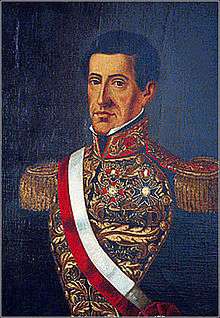Peruvian civil war of 1834
The Peruvian civil war of 1834 was a revolt by supporters of former president Agustín Gamarra against the government. Gamarra had wanted Pedro Pablo Bermúdez as his successor to the presidency instead of Luis José de Orbegoso. On April 17, 1834, the two sides clashed in the Battle of Huaylacucho, in Huancavelica resulting in a victory for the revolutionaries. On April 24, 1834, there was another clash near Jauja. Although the revolutionaries, Obregoso was overthrown the next year by Felipe Santiago Salaverry, sparking the Salaverry-Santa Cruz War.
| Peruvian civil war of 1834 | |||||||
|---|---|---|---|---|---|---|---|
 Portrait of Agustín Gamarra | |||||||
| |||||||
| Belligerents | |||||||
| Government of Peru | Revolutionaries | ||||||
| Commanders and leaders | |||||||
|
Luis José de Orbegoso Guillermo Miller Felipe Santiago Salaverry |
Pedro Bermudez José Rufino Echenique | ||||||
The Peruvian Civil War of 1834, also known as the Bermúdez Revolution, was a conflict that began in Peru after the election of General Luis José de Orbegoso as the country’s provisional president. Former president and General Agustín Gamarra, unhappy with election results, incited General Pedro Bermúdez to stir up a rebellion against the new government. The rebellion began in January of 1834. The people divided themselves into two factions: the Bermudistas and the Orbegosistas. After several months of fighting on different fronts, the factions peacefully reconciled in what is called the Embrace of Maquinhuayo.[1] This was the first civil war in the history of Peru as a republic.
Context
On December 20, 1833, the constitutional term of President Augustín Gamarra ended. Because a successor had not been chosen due to failed elections months before, the National Convention (a congress of constituents) agreed to choose a provisional president.[2] Gamarra and the conservatives supported candidate General Pedro Bermúdez, while the liberals that dominated the assembly supported General Luis José de Orbegoso, a less authoritarian soldier. Francisco Xavier de Luna Pizarro, the famous liberal clergyman who presided over the assembly, was like a son to Orbegoso. The other candidate was General Domingo Nieto. The voting was carried out in the midst of the Convention, where Orbegoso received 47 votes, Bermúdez received 37, and Nieto received only one.
Orbegoso assumed power on the 21st of December, 1833, counting on the approval of the city. His ascension to power meant the end of Gamarra’s government, which had been worn down because of his authoritarian beliefs. However, the supporters of Gamarra, who continued to control key positions of power, harassed the new administration with the intention of demolishing it and placing Bermúdez as the new president.[3] They claimed that the presidency of Orbegoso was illegal because it was not the National Convention’s place to select the president.
References
- Scheina, Latin America's Wars, 133.
- Perea, “Power of the Law or Power of the Sword", 224.
- Delaney, “General Miller and the Confederación Perú-Boliviana”, 218.
- Basadre Grohmann, Jorge: Historia de la República del Perú (1822 - 1933), Tomo 2. Editada por la Empresa Editora El Comercio S. A. Lima, 2005. ISBN 9972-205-64-9 (V.2)
- Chirinos Soto, Enrique: Historia de la República (1930-1985). Tomos I. De San Martín a Leguía. Lima, AFA Editores Importadores S.A., 1985.
- Vargas Ugarte, Rubén: Historia General del Perú. La República (1833-1843). Octavo Tomo. Primera Edición. Editor Carlos Milla Batres. Lima, Perú, 1971.
- Tristán, Flora: Peregrinaciones de una paria. Serie “Peruanos Imprescindibles”, Libro 8. Impreso y publicado por la Empresa Editora El Comercio S.A., Lima, 2005. ISBN 9972-205-88-6
- Varios autores: Historia general de los peruanos. Tomo 3. Primera Independencia Nacional y Revolución Peruana. Con el auspicio del Gobierno Revolucionario de las Fuerzas Armadas. Impreso en Talleres Gráficos de Iberia S.A. Lima, agosto de 1973.
- Delaney, Robert W. “General Miller and the Confederación Perú-Boliviana.” The Americas, vol. 18, no. 3, Jan. 1962, pp. 213–242.
- Perea, Natalia Sobrevilla. “Power of the Law or Power of the Sword: the Conflictive Relationship between the Executive and the Legislative in Nineteenth-Century Peru.” Parliaments, Estates and Representation, vol. 37, no. 2, 29 June 2017, pp. 220–234., doi:10.1080/02606755.2017.1334326.
- Scheina, Robert L. Latin America's Wars: the Age of the Caudillo, 1791-1899. Vol. 1, Brassey's, Inc., 2003.